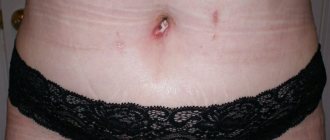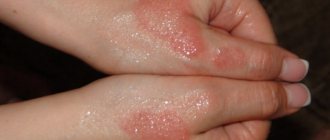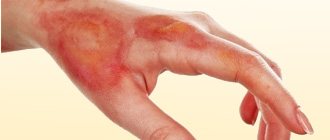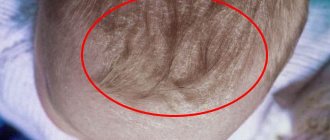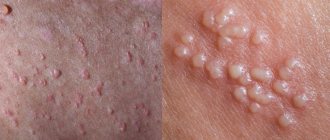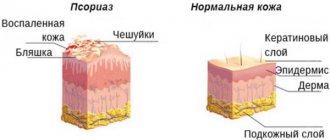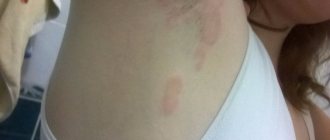Dermatitis on the eyelids is a fairly common phenomenon, affecting only the area around the eyes. However, the symptoms and causes of the disease are quite diverse, so only a doctor can diagnose eyelid dermatitis, the treatment of which will depend on the form: allergic, atopic or seborrheic dermatitis. In addition, concomitant disorders include various types of infections, psoriasis and even serious tumors. Therefore, if symptoms of dermatitis appear, you should immediately seek medical help.
Why does eyelid dermatitis appear?
The reasons that result in dermatitis on the eyelids can be of different nature. The most common provocateurs that cause the disease:
- allergic responses of the body to chemicals, hygiene products, decorative cosmetics, medicines, products, household provocateurs, synthetic clothing;
- prolonged use of ointments and/or creams with corticosteroids and eye drops;
- immune response to natural allergens: plant pollen, insect bites;
- autoimmune dysfunction;
- diseases of an infectious nature (viral, bacterial, fungi);
- pathology of the gastrointestinal tract.
When the skin comes into direct contact with a chemical or cosmetic, redness around the eyes occurs within an hour, in which case the provocateur is not difficult to find. This pathology is also called contact or periorbital dermatitis in medicine. In cases where allergies appear on the skin of the eyelids due to hormonal, autoimmune or digestive disorders in the body, then it is more difficult to identify the allergen. If a crust on the skin forms in infancy, the disorder may be hereditary.
Causes of the disease
Dermatitis of the eyelids is a polyetiological disease. Factors contributing to the development of the pathological process may be:
- atopic reactions;
- exposure to environmental factors (prolonged exposure to sunlight, severe frost, ionizing radiation);
- herpes zoster, scarlet fever, herpes, measles and other infectious diseases;
- contacts with aggressive chemicals (when using cleaning products at home, while working in hazardous industries, etc.);
- dysfunction of the sebaceous glands, characterized by increased production of fat.
In addition, the causes of eyelid dermatitis can be hypersensitivity reactions to drugs, foods, animal hair or pollen.
What forms exist
Experts identify several forms of dermatitis, which differ in symptoms and severity.
Acute form of pathology
Dermatitis around the eyes becomes pronounced in cases where the provocateur has previously attacked the body. Each encounter with an allergen of the same type will provoke an immediate exaggerated reaction. Symptoms of the acute stage of the pathology are as follows:
- thin skin instantly turns red and incessant itching appears;
- Severe swelling occurs, the skin in this area becomes hot, and the eye may close completely;
- the eyelid becomes dry and the skin becomes rough;
- Bubbles or weeping areas may appear.
The patient's general condition becomes severe, chills, lacrimation and cutting pain in the eyes, dizziness, and severe weakness appear. In addition, the patient is susceptible to increased excitability and sleep disturbances.
Chronic form of eyelid dermatitis
The chronic stage does not appear immediately, but develops over a certain period of time. The symptoms of this stage have a constant, pronounced course:
- burning and sharp pain in the eyes;
- thickening of the stratum corneum occurs;
- swelling worsens, redness becomes pronounced;
- a rash appears that can transform into conjunctivitis.
The pathology affects both eyes, the swelling becomes symmetrical. Dermatitis often progresses to a chronic stage with constant contact with an allergen or improper treatment of disorders.
Folk remedies
It is advisable to combine drug treatment of eyelid dermatitis with the use of time-tested alternative medicine.
Traditional healers advise using the following therapeutic regimens::
- Pour 70 g of crushed hop cones and 50 g of string grass into a thermos. Pour boiling water (170 ml) over the vegetable mixture and leave for 2 hours. Cool the finished infusion and pass through cheesecloth. Soak a sterile napkin with the resulting liquid and apply it to the sore eyes for 20-25 minutes.
- Combine aloe juice and castor oil (1:1). Apply the composition to the inflamed eyelids using a cotton swab and leave for half an hour.
- Grate a large potato tuber without peel on a fine grater. Place the mixture on a sterile gauze pad and apply to your eyes for 20 minutes. This method is very effective in treating atopic dermatitis on the eyelids.
- Mix 1/5 cup melted lard with 2 teaspoons of sea buckthorn oil. Keep the resulting mixture in the refrigerator for 6 hours. Use ointment to treat inflamed areas.
- Prepare a mixture of nettle, chamomile, oregano and cornflower (take all components in equal quantities). Pour boiling water (400 ml) over a handful of the mixture and leave in a warm place overnight. Make cold lotions based on the infusion.
- Pour 2 teaspoons of dry licorice leaves, string grass, chamomile flowers, black currant bark and viburnum berries into a thermos. Add 700 ml of boiling water to the mixture and leave overnight. Take the infusion orally, 50 ml four times a day.
- Grind a handful of Japanese sophora fruits. Pour 1 tbsp into the pan. spoon of the resulting powder and pour it with a glass of water. Place the mixture on the fire and boil it for 17 minutes. Drink the strained broth throughout the day.
We must not forget that all alternative medicines have contraindications and side effects. Therefore, the use of any of them should be agreed with your doctor.
Types of dermatitis
There are several types of dermatitis, differing in the degree of progression of symptoms and the factors affecting the appearance of pathological changes.
Allergic type of pathology
Allergic or periorbital dermatitis on the eyelids occurs when the allergen comes into direct external contact with the human body. The most common provocateurs are chemical compounds, cosmetics, animal hair, plant pollen, and insect bites. There are common characteristics of a contact form:
- the eyelid itches and swells greatly;
- swelling spreads to the eyeball and lacrimal apparatus;
- tearing appears;
In addition, papules with transparent contents may appear. Allergic dermatitis, localized on the eyelids, is easier to diagnose than other types of disease, since the reaction to the allergen develops quite quickly. However, in medical practice, this type of lesion is less common than other forms.
Atopic type of dermatitis of the eyelids
Atopic dermatitis is localized on both eyelids, or affects separately the upper skin borders or the lower skin borders of the eye. This dysfunction is chronic and characterized by frequent periods of exacerbation. The causes of this disease are of different nature:
| External factors | Internal factors |
|
|
Symptoms of the atopic form have common features:
- unbearably itchy eyelid;
- the formation of small whitish papules, which, after opening, transform into weeping areas;
- formation of crusts and microcracks.
Atopic dermatitis, which appears on the eyelids, is dangerous because severe itching provokes scratching of the affected areas. This behavior is typical for children who cannot control their emotions, and leads to infection and suppuration of the conjunctival sacs.
Seborrheic type of eyelid dermatitis
Seborrheic dermatitis is a skin inflammatory process caused by a pathogenic group of lipophilic fungi. The disease often transforms into a chronic form and is characterized by severe peeling of the affected area. Seborrheic dermatitis is localized on the eyebrows, armpits, groin and other areas of the body saturated with sebaceous glands. Symptoms of pathology around the eyes are very characteristic:
- in addition to itching and redness, scaly keratinized layers appear along the eyelash growth line;
- there is dryness of the cornea and a sensation of a foreign body pressing on the eyeball;
- growth is disrupted and eyelash loss occurs.
In severe cases, seborrheic dermatitis affects the eye, vision deteriorates, and the cornea is damaged. If the above signs appear, you should immediately seek medical help, because seborrheic dermatitis of the eyelid area is similar in symptoms to a more complex disease - seborrheic blepharitis.
We wrote about methods of treating (viral) infectious dermatitis in children here: https://psoriazweb.ru/dermatity/vidy-i-metody-lechenija-infekcionnogo-dermatita.html
If you want to know what the first signs of atopic dermatitis are in adults and children, we recommend reading our publication.
Read which ointment is most effective for allergic dermatitis!
Medicinal or medicinal type of eyelid dermatitis
This form is the most common type of pathology. Drug dermatitis is called because the body reacts to medications: eye drops, ointments. The symptoms of the disorder are similar to the acute phase of dermatitis, but have special features:
- with severe swelling of the inner corner of the eye and redness of the eyeball, eye drops are usually used as an allergen;
- in cases where the ointment acts as an aggressor, the lesion spreads beyond the upper and lower ciliary contour.
The dosage form of dermatitis is complicated by the fact that it can provoke the development of allergic conjunctivitis. In addition, a course of electrophoresis procedures can provoke the development of pathology.
Eczematous type of dermatitis on the skin of the eyelids
This type of disease is less common than other forms of dermatitis and occurs under the influence of internal and external factors. Among them are:
- antiviral dosage forms;
- ointments and creams – antibiotics;
- pathology of the gastrointestinal tract;
- physiotherapeutic procedures;
- helminthiasis
The symptoms of eczematous pathology are similar to other types of dermatitis:
- Pain in the eyes;
- redness, swelling and itching of the affected surface;
- the appearance of small bubbles;
- the upper and lower eyelids are affected.
To prevent the development of this type of disease, you should carefully monitor the body's reactions to medications.
Herpetic type of eyelid dermatitis
Herpetic or viral dermatitis of the eyelids is caused by the herpes virus, the characteristic feature of which is grouped blistering rashes in the affected area. Irritation on the eyelids can have different viral forms:
- The simple type of virus is characterized by redness and the appearance of watery blisters, which dry out and form crusts as the disease progresses. Self-separation of crusts and complete regeneration of the skin occurs two weeks after the onset of progression of the pathology. The eyelid becomes clean. The disease is accompanied by headaches, chills, and fever. Sometimes these symptoms are exaggerated.
- Herpes virus type 3/herpes zoster affects the ophthalmic trigeminal nerve and the ciliary ganglion. The lesion may affect both the upper eyelid separately and the lower eyelid separately, or both eyelids. Before the formation of blisters on the skin, the patient experiences strong aching pain in the area of the trigeminal nerve. Scars form on the skin in the regression stage after the ulcers heal.
Viral dermatitis is dangerous because the pathology can affect the nasociliary nerve and cause damage to the cornea. In especially severe cases, herpes affects the central nervous system and can trigger the development of meningitis.
Contact dermatitis of the eyelids
Contact dermatitis is the most common type of inflammation of the skin of the eyelids, resulting from contact with a sensitive area by a direct provocateur or transfer of an allergen to the skin with the hands. Typically, contact dermatitis comes in two forms: allergic and irritant. Characteristic symptoms of contact dermatitis:
| allergic contact dermatitis | irritant contact dermatitis |
|
|
In addition to chemicals, detergents and decorative cosmetics, the following substances can be provocateurs: dust, poisonous plants, nail extensions and eyelash applicators, hair dye, nail polish, ophthalmic solutions.
Psoriasis on the eyelid
Psoriasis, localized on the eyelid, is one of the incurable chronic forms of pathology. This disorder is of an autoimmune type and has a severe course. Psoriasis is dangerous due to the addition of secondary diseases and various kinds of complications:
- diabetes;
- hypertension;
- cardiac ischemia;
- psoriasis arthritis;
- psoriatic erythroderma;
- complete loss of vision.
Factors that provoke the development of psoriasis:
- genetic predisposition;
- autoimmune nature of the disease;
- severe nervous stress;
- eyeball injuries;
- hormonal disorders;
- contact with the mucous membrane of the eye of strong toxic substances.
The symptoms of the disease are pronounced:
- the pathology progresses quickly, a few hours are enough to damage the skin and eyes;
- the pathological process penetrates into the eye, affects the blood vessels and the eyeball;
- severe tearfulness;
- the pain is quite acute, and the swelling of the eyelids and eyes is impressive.
If left untreated, psoriasis can cause serious harm, provoke secondary skin diseases and completely paralyze vision.
Types and symptoms
There are several types of ocular dermatitis.
Atopic
In this case, both eyelids are affected - lower and upper. Its development can be provoked by multiple reasons, both internal and external. As pathology manifests itself, the skin begins to roughen and crack.
Chronic
This species is characterized by a slow development of the inflammatory process. If, in the case of an acute lesion, only one eye is exposed to suffering, then here the location of the lesion falls on both visual organs.
There is redness of the eyelids, peeling of the skin and severe itching. This form is also accompanied by swelling and rashes.
Drug
Its occurrence is facilitated by taking a certain group of medications or electrophoresis. In case of damage to large corners of the eyes, we can say that the cause of the disease was the use of eye drops. If the entire surface and conjunctiva are affected, use ointments.
Eczematous
It is extremely rare. It may occur due to the use of ointments containing sulfonamide components. It can also be caused by taking certain antibiotics. The main symptoms are itching, redness, and pain in the eyes.
Seborrheic
This type is characterized by signs such as redness of the skin, decreased vision, itching, a feeling of sand in the eyes, and loss of eyelashes. Only this type of disease is distinguished by the formation of a yellow crust on the eyes that has scales.
Spicy
Its difference lies in the abrupt onset of the course, which is accompanied by an increase in body temperature and rapid swelling of the eyelids. In some cases, dizziness and chills may occur.
Whatever the form of inflammation, you must immediately seek help from a specialist.
Diagnostics
To correctly diagnose the disease, it is necessary to conduct a series of consultations with a dermatologist, ophthalmologist and allergist. The diagnosis of periorbital dermatitis is based on a history of:
- Visual examination, accompanied by the collection of information about genetic factors and susceptibility to allergic reactions. In addition, possible provocateurs and the frequency of pathological manifestations are clarified.
- Complete blood count and eosinophil test.
- Laboratory skin tests to identify the triggering allergen.
In addition, specialists identify the presence of concomitant ophthalmological and dermatological diseases that may affect the accuracy of the diagnosis.
Causes and manifestations of eyelid dermatitis, features of skin restoration
The eyelids protect the eyes from light, dirt and dust. The skin around them is very thin, has no fatty tissue, collagen, or sebaceous glands, but it has to constantly strain so that the eyelids can perform their functions. Ultraviolet rays, wind, and dry air worsen the condition of the skin.
Dermatitis affects different parts of the body. The skin on the eyelids and around the eyes is not immune to the disease. In response to the irritant, it swells and turns red, becomes covered with a rash, and over time becomes rough and cracked.
Treatment of eyelid dermatitis
Dermatitis of the eyelids involves complex treatment, including not only the use of medications, but also a complete rejection of any type of cosmetics and decorative cosmetics.
How to treat atopic dermatitis
Atopic dermatitis must be treated in combination using different groups of medications:
- Solutions and lotions with antiseptic agents relieve inflammation and eliminate weeping wounds (potassium permanganate solution, zinc sulfate tablets, Fukortsin, Furacilin, Resorcinol).
- Anti-inflammatory ointments, softening, exfoliating the stratum corneum and restoring the epidermis (ichthyol, tar ointments).
- In cases where dermatitis under the eyes is manifested by a progressive inflammatory process, it is necessary to use corticosteroid ointments and antibiotics (Advantan, Methylprednisolone, Fluorocort, Lokoid, Akriderm, Geocorton, Gioxysone).
- To relieve allergic swelling, itching and neuroses caused by the disease, antihistamines (Erius, Suprastin, Cetrin, Chloropyramine) are used.
Atopic pathology causes severe itching and is especially severe in children, so the use of antihistamines is simply necessary.
You can learn how and with what to treat weeping skin using our publication.
Why dermatitis appears on the face and what forms exist are described in this article. Find out more!
How to treat herpetic dermatitis
Herpetic dermatitis, localized under the eyes, involves treatment of two stages: herpes simplex and herpes zoster type 3:
- The first stage involves eliminating weeping wounds, softening crusts and regenerating the skin with the help of ointments (Oxolinic ointment, Acyclovir). In the regression stage, a course of immunomodulatory vitamin groups (Complevit, Duovit, Vitrum) is recommended.
- Type 3 herpes, which affects the eyelid, is treated with the same ointments as herpes simplex; in addition, analgin/aspirin tablets are used to relieve inflammation. In some cases, for severe pain, analgin is administered intramuscularly or novocaine blockades are used.
In cases where the herpetic type progresses in parallel with concomitant diseases, broad-spectrum antibiotics (Ampicillin) are used.
Treatment of eczematous dermatitis of the eyelids
Eczematous dermatitis is characterized by severe redness and the development of weeping cracks, so treatment of this form is aimed at eradicating these problems:
- at the initial stage of pathology formation, drying zinc paste is used;
- the affected eyelid is treated with ointments and hormonal sprays (Fukortsin, Gentamicin ointment, Oxycyclosol aerosol;
- therapy is carried out to normalize the activity of the digestive system.
Eczema affects not only the eyelid, but also paralyzes a large surface of the skin around the eyes.
Treatment of allergic dermatitis of the eyelids and other forms and types
Dermatitis on the eyelid involves the following treatment:
- the use of anti-inflammatory, drying and antibacterial ointments (Flumetasone, Lorinden, Mometasone) that relieve itching and burning sensation;
- antihistamines that relieve swelling and normalize the patient’s mental state (Zyrtec, Suprastin, Tavegil).
The main factor contributing to the regression of the disease is a complete rejection of cosmetics, household chemicals and other aggressors.
Additional drug therapy
Each case of the disease is individual, so doctors draw up additional treatment cards for the patient:
- for atopic and allergic dermatitis, it is necessary to take antibacterial drugs;
- some patients are prescribed immunostimulants and immunomodulators along with active medication use;
- To restore the proper functioning of the nervous system, the doctor prescribes sedative tinctures. In severe cases, strong sedatives (Diazepam, Oxazepam) are prescribed;
- To cleanse the body of toxins released by the microbial environment, it is necessary to take enterosorbents (Polysorb);
- probiotics are necessary for digestive disorders (Normabakt, Lenex, Enterol);
- To improve the passage of food, Festal, Enzistal, Mezim are prescribed.
The patient must follow a specialized diet, including the intake of hypoallergenic foods.
Physiotherapy for eyelid dermatitis
Physiotherapeutic procedures can significantly alleviate the patient’s condition. However, you need to know that not all types of dermatitis can be treated in this way. So, the affected eyelid can be cured with the following procedures:
- A light specialized massage to relieve itching in the affected areas is carried out next to the inflamed areas, without affecting the eyelid.
- Use of ultraviolet rays to disinfect and reduce bacterial growth.
- Magnetic therapy is prescribed to reduce swelling and relieve pain.
- Reflexology is intended to relieve severe itching and swelling of tissues.
- Therapy using a point laser is indicated for eliminating redness, swelling and rapid regeneration of the skin.
In addition, the doctor may prescribe the patient paraffin applications on the eyelid, or compresses with the natural hydrocarbon ozokerite.
Treatment of eyelid dermatitis in a child
If a child experiences redness and flaking on the eyelids, parents should immediately seek medical help. Only a specialist can make a diagnosis and prescribe proper treatment. Most often, allergic pathology manifests itself in infants and older children. The reasons for its occurrence:
- improper diet of the mother while breastfeeding;
- reaction to baby powders, creams and other chemicals;
- allergies to pets;
- food allergy in a child.
The main principle of getting rid of the disease in this case is the exclusion of the aggressor. In addition, the allergist may prescribe antihistamine ointments; for infants, oral drops (Zyrtec).
Homeopathy for eyelid dermatitis
Contrary to popular belief, homeopathic medicines can only be used after consultation with a specialist. For dermatitis, the doctor may prescribe the following forms of medications:
- to eliminate skin manifestations, Sulfur C6 is prescribed, the main component of which is sulfur;
- visible redness of the eyelids is relieved by herbal preparations (Aconitum, Lycopodium);
- papules regress when using homeopathy based on purified resins and marine components (Petroleum, Cantharis, Calcarea carbonica).
- eliminate the seborrheic form of dermatitis, remove flaky crusts, clean the eyelid, a drug based on white arsenic oxide Arsenicum album will help;
- eczematous dermatitis and eating disorders associated with it, the doctor prescribes the herbal preparation Iris;
- Scars that form after herpetic dermatitis will be eliminated by calcium fluoride, Lachesis.
Homeopathic medicines often have a strong medicinal composition, so only a doctor can prescribe them. The patient may have an allergic predisposition to a certain component of homeopathy, so self-medication is contraindicated.
ethnoscience
Alternative medicine will help cure periorbital dermatitis only in combination with medications and therapeutic procedures. Before using traditional recipes, you should consult a dermatologist, because some herbs can cause progression of the disease. The most common recipes for relieving symptoms of dermatitis:
- Decoctions and infusions. The most popular wound-healing and antiseptic herbs are chamomile, celandine, and string. You can prepare decoctions by pouring a tablespoon of any of these herbs with water and boiling over a fire. The cooled broth is not stored; it is used fresh. After soaking a sterile cloth with this product, apply to the affected areas. You can gently rub your eyes with chamomile infusion.
- Aloe juice has a moisturizing, softening effect, heals and disinfects the skin. One teaspoon of juice is enough to apply the product to the affected areas for 15-20 minutes.
- Applications with oils. Tea tree and eucalyptus oils are used for an antiseptic effect for dermatitis. However, it is necessary to check whether the body reacts to these drugs. To do this, it should be applied to an unaffected area of skin. For allergic dermatitis, these remedies are excluded. In other cases, a few drops of eucalyptus or tea tree oils are added to olive oil and applied with sterile cotton swabs to the area around the eyes.
In addition to the above remedies, you can use applications with a decoction of coltsfoot, plantain, and marshmallow. Even with regression of the disease, alcohol infusions are not recommended for use when the thin skin of the eye is affected, so as not to burn it and cause repeated relapses.
Treatment methods
Treatment tactics for dermatitis around the eyes depend on the etiology of the disease.
For an inflammatory process of herpetic origin, the treatment regimen includes :
- treatment of loose elements with ointments that contain acyclovir;
- taking immunomodulators or recombinant interferon (course duration - 14 days);
- administration of a herpetic vaccine 1.5 months after the disappearance of symptoms of the disease.
For allergic dermatitis, therapy begins with eliminating the irritants. Patients are advised to take antihistamines and treat the skin around the eyes with corticosteroid creams. In case of pronounced hypersensitivity reactions, the patient may be prescribed a short course of hormonal therapy.
For atopic dermatitis in the eyes, treatment boils down to following a hypoallergenic diet, detoxifying the body and taking antihistamines. In addition, patients are advised to treat the affected areas with anti-inflammatory creams daily. In rare cases, patients are prescribed sedatives (glycine, valerian).
Persons who have been diagnosed with seborrheic dermatitis around the eyes are recommended to use calcineurin inhibitors in combination with topical glucocorticosteroid drugs. In addition, the therapy program includes :
- lotions with anti-inflammatory solutions;
- H2-histamine blockers (for severe itching);
- sedatives.
To prevent bacterial complications, an alcohol solution of brilliant green or other aniline dyes is applied to the patient’s upper and lower eyelids.
Prevention of dermatitis and its relapses
Dermatitis is of an allergic nature, but relapses of the disease can be avoided by carrying out a daily set of preventive measures:
- Use only individual personal hygiene products.
- Carefully select decorative cosmetics and household chemicals, studying the composition, and exclude from use products that can cause an individual reaction in the body.
- When working with chemicals, wear protective clothing, a mask, goggles, and gloves. If possible, allergy sufferers should avoid such work.
- Allergen residues can get into your eyes through your hands. Therefore, it is necessary to do wet cleaning in the apartment, wash your hands thoroughly, and follow hygiene rules.
- Do not abuse medications.
In addition, you should follow a sleep and rest schedule, do simple gymnastic exercises and strengthen your immune system. As skin dermatitis progresses, the use of any cosmetics should be excluded and the provoking allergen should be eliminated from life.
Prevention
To prevent the formation of various types of dermatitis on the eyelids, you need to follow the recommendations:
- you need to carefully choose personal hygiene products and decorative cosmetics; low-quality cosmetology products can cause allergic dermatitis;
- Observe strict hygiene rules daily using soap with an antibacterial effect;
- if you are prone to hay fever during the period of large-scale flowering of plants, you need to do wet cleaning of the premises daily;
- If you have poor vision, change contact lenses every day or wipe your optical glasses several times a day with special wipes. Even if the lens manufacturer claims that daily changing is not necessary;
- in case of secondary infection, it is worth treating the surface with an antibacterial agent;
- personal cosmetics - mascara, eye shadow and pencils should be for individual use.
How to treat allergies
The eyelids become inflamed when a person comes into contact with household chemicals, with tree pollen, under the influence of mercury, lead, essential oils, sun rays, due to the consumption of citrus fruits, strawberries, and peanuts.
Allergic dermatitis affects the skin near one eye.
Treatment for this type of disease includes:
- elimination of the pathogen;
- taking medications;
- diet;
- treatment of inflamed areas.
If the skin reacts with irritation to a food product, the stomach is cleansed with sorbents and herbal decoctions. If you are allergic to household chemicals or cosmetics, you have to stop using them.
Pills
To eliminate the reaction of the skin of the eyelids to the causative agent of dermatitis, antihistamines are taken in the form of Suprastin, Telfast, Tavegil, Aleron. If the pathology has progressed to an advanced form, systemic corticosteroids in tablets are prescribed - Dexamethasone or Prednisolone.
If a microbial infection occurs when scratching the rash, antibiotics must be used. Doctors usually prescribe drugs that belong to cephalosporins or macrolides.
Sedatives are taken when severe itching prevents you from sleeping normally and irritates the nervous system. For this purpose, Persen, Glycine, or a more serious medicine, the tranquilizer Fenozepam, is prescribed.
Taking calcium gluconate helps reduce sensitivity to allergens that trigger dermatitis.
Ointments and creams
Inflamed areas are treated with Solcoseryl and Fenistil-gel. Antiseptic Wunderheel disinfects the skin and heals cracks.
The product used for external use contains natural ingredients in the form of tinctures of sophora, propolis, and yarrow.
Ketocin ointment quickly relieves inflammation, disinfects, and relieves itching. Accelerates the healing of the epithelium, eliminates hyperemia of the eyelids Panthenol.
